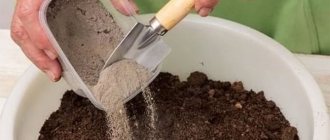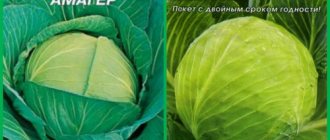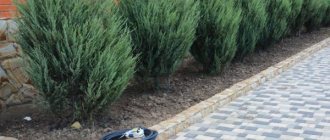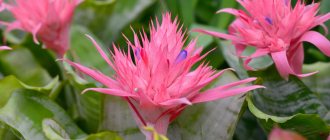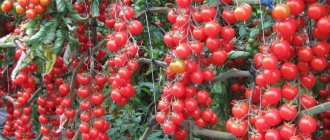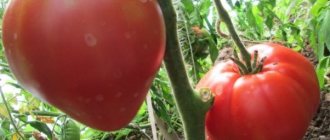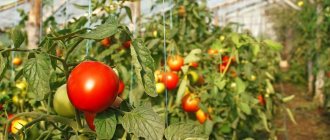Characteristics and description
Raspberry ringing is a 1st generation hybrid bred by domestic breeders. Therefore, you need to take into account that, although it has impressive high qualities, it is somewhat more demanding in terms of care. However, this does not stop those who, having once grown this miracle, purchase seeds every season and plant it again on their plot.
Portrait of a Raspberry Ringing tomato only emphasizes all the most attractive and useful qualities of the variety.
Description of the bush
- determinant;
- early ripening: fruits ripen 95-105 days after emergence;
- standard: the root system is not very developed, does not go deep, and grows in breadth by about 50 cm;
- compact bush: grows up to 50 cm in open ground, up to 120 cm in closed ground;
- however, the stem is strong enough to support a mass of ripe tomatoes;
- the leaf mass increases as usual for most typical varieties;
- the leaves are also ordinary: dark green, pubescent, medium size, slightly wrinkled;
- of the intermediate type, simple inflorescences are laid above the fifth or sixth leaf, the first, the next every two leaves;
- the tomato stalk has a strong articulation;
- about eight brushes of a simple type are formed on the bush;
- On average, six to eight large tomatoes develop on each cluster;
- the yield is consistently high: from one bush you can get 4-5 kg of large pink-raspberry tomatoes;
- bushes require tying up because they can lie down under the weight of the fruit;
- to obtain larger, high-quality fruits, the bush, although it is determinate, should be pinched shoots as needed;
- stepsoning is mandatory;
- it is possible and recommended to form a bush with 1-2 stems;
- excellent keeping quality;
- very good transportability.
In protected ground, the bushes grow up to 1.2 cm and produce a larger harvest than in the garden. However, in open ground the fruits are more tasty and fragrant.
Since Raspberry Ring is a hybrid, seeds collected from its tomatoes will not produce fruits of this variety next season. You can experiment, but in any case the result will not be a Raspberry Ring, but an “unknown little animal.”
Description of fruits
Raspberry ringing tomato fruits attract with their outstanding qualities:
- the fruits reach an average of about 300 g;
- diameter on average about 10 cm;
- by pinching the shoots and adjusting the number of inflorescences in the cluster, you can get larger fruits;
- tomatoes are round, medium, dense;
- pink-raspberry tomatoes;
- during ripening, the color of the tomato changes from light green to deep pink;
- difference from other varieties: there is no dark green spot near the stalk;
- skin: glossy, shiny, smooth, thin, but does not crack;
- the taste is balanced, sweet, similar to the taste of watermelon;
- the pulp is quite fleshy, medium density, juicy, fragrant;
- seed chambers: 3-4 pieces;
- very few seeds;
- dry matter: below average;
- Fruits can also be collected at the stage of blanzhe ripeness;
- tomatoes ripen perfectly;
- successfully stored at t – 20°-22°C in a dark, dry place.
Description of the tomato variety Raspberry ringing indicates the excellent commercial qualities of this tomato, which attracts farmers and those who grow tomatoes on an industrial scale:
- stable high yield;
- the fruits ripen perfectly;
- can be stored for a long time;
- do not lose their presentation during transportation.
Farmers are not stopped even by the fact that the Raspberry Zvon variety is more demanding of care.
It is better to pick tomatoes for sale when they are slightly underripe, especially if they need to be transported over long distances. This way the tomatoes will better withstand long-term transportation. When placing the fruits in a warm place, they will quickly reach marketable ripeness.
Purpose
The purpose is mainly salad, for fresh consumption, for sauces, stewing, pickling (in large containers with a wide neck). They are not very suitable for canning, especially whole fruits: they fit into the neck of a 3-liter jar with great difficulty, unless you still manage to collect smaller fruits from the bush, but even those may not fit.
Raspberry ringing tomatoes are perfect for technical processing: juices, ketchups, and pastes from them are very tasty and aromatic.
Origin
The variety was developed by domestic breeders and entered into the State Register of Raspberry Zing in 2009. Originator Scientific and Production JSC. The variety is intended for cultivation in open and closed ground.
It is most productive in the southern regions, but grows and successfully bears fruit throughout the Russian Federation.
Features of a standard plant
The tomato variety Raspberry Ring is distinguished by its small bush height. It reaches a height of fifty-five centimeters, and in greenhouses - a little more than a meter. The bush is compact with a medium number of wrinkled dark green leaves. The root system of the plant is poorly developed and has a diameter of fifty centimeters.
Since the Raspberry Ring is determinant, its flower clusters are formed after the appearance of the fifth or sixth true leaf. After two to three leaves, the next ovaries appear.
As a first-generation hybrid, the tomato variety is resistant to many diseases that affect vegetable crops: fusarium, tobacco mosaic, late blight.
Resistance to diseases and pests
The Raspberry Ring tomato, thanks to the excellent work of breeders, turned out to be very resistant to diseases characteristic of tomatoes. He has a fairly strong immune system and a high degree of immunity to:
- late blight;
- Alternaria;
- viral mosaic;
- fusarium;
- tobacco mosaic.
However, good immunity and high resistance to disease infection do not mean that there is no need to take measures to prevent disease infection and prevent pest attacks:
- other plants from the nightshade family, which share diseases and pests with tomatoes, should not be planted close to tomatoes;
- do not thicken the tomato plantings;
- tie up bushes for better ventilation and sunlight;
- avoid over-watering (it is better to under-water than to over-water);
- in the greenhouse, monitor the temperature and light level, ventilate regularly;
- also regularly inspect plants for pest damage;
- preventive spraying with fungicides and insecticides can be carried out (before the beginning of the growing season and fruit formation);
- plant useful nurse plants next to the tomatoes that will repel pests and some viruses.
Greenhouses should be kept clean, and the room and soil should be disinfected before planting seedlings in it.
If you follow the easy rules of crop rotation, the parameters of planting bushes, the rules of agricultural technology, the threat of disease infection and pest damage can be minimized, which will save the owner of the site time, money, and ensure a rich harvest.
The nuances of growing in open ground and in a greenhouse
In the greenhouse, the soil is cultivated in the fall. It is recommended to disinfect the soil and structure using fungicides. Fungicides are a group of drugs that prevent the occurrence of diseases.
In addition to the soil, also treat organic plant residues. “Quadris” is recognized as an excellent remedy. This is a complex remedy that protects Raspberry Ring, powdery mildew, and white spotting.
When growing tomatoes in open ground, pay attention to the “neighbors” of the crop. It is not recommended to plant tomatoes next to potatoes or other varieties of tomatoes. If one bush becomes infected, the likelihood of infecting all the others increases. Experienced farmers also plant basil near tomatoes. This plant improves the taste of Raspberry Ring.
Advantages and disadvantages
Every plant has its good and bad qualities. The same applies to the Raspberry Zing variety.
Advantages:
- large fruit;
- precocity;
- balanced excellent taste;
- high stable yield;
- strong immunity and resistance to diseases and pests;
- can be stored very well and for a long time:
- ripens well;
- It can easily withstand even long-term transportation without losing its high commercial qualities.
Here we can add the almost universality of use and use.
Flaws:
- For some, the disadvantage may be the inability to obtain their seeds from this wonderful hybrid;
- demanding care (although if you follow generally simple agricultural practices, you can grow it without problems).
And these are the only complaints about the variety. No other deficiencies have been identified over the years.
Errors during cultivation
The most common mistake when growing the Raspberry Zvon F1 variety is insufficient or too much watering of the bushes. To add the amount of water the plant needs, it is worth observing it. If the skin of the tomatoes has become hard and the fruits themselves have begun to shrink, it means that you need to water more.
If they become watery and taste bland - less often. Also, you should not get carried away with fertilizers to avoid fattening the bushes.
The best low-growing tomatoes 2021! Tomato varieties Vano, Nastenka, Raspberry ringing.
SUPER YIELD TOMATO RASPBERRY EMPIRE! BEST TOMATOES OF THE SEASON!
Raspberry miracle from “Gardens of Russia”!
Features of growing the variety
The hybrid tomato variety Raspberry Ring is a little more demanding in terms of care, but it’s worth it: in response to attention and care, the tomato will respond with a rich harvest of very tasty, sweet, beautiful fruits. In general, the agricultural technology for growing Raspberry Zing is not much different from the agricultural technology typical for other varieties of tomatoes. However, there are some nuances in growing this variety.
To grow healthy, strong seedlings, you should take care of the seeds:
- you should purchase seeds only from trusted companies;
- check the expiration date;
- in any case, it is advisable to disinfect the seeds in at least a deep pink solution of potassium permanganate (soak for 30-40 minutes);
- rinse and soak in water for 24 hours (changing the water every 2-3 hours to prevent the seeds from suffocating);
- the seeds can also be soaked in growth stimulants (according to the instructions for each product).
Then the seeds should be dried on a paper napkin (you can also use toilet paper).
Growing seedlings
Seeds for seedlings should be sown after February 20th. It is possible - until the end of March (depending on the region and soil protection).
To germinate seeds and for seedlings to grow successfully, the soil must be prepared.
- It is better to purchase special soil for tomatoes, or for nightshades, or for any seedlings. If the soil is taken from the garden, it should be disinfected (you can spill it with a dark solution of potassium permanganate, for example). The soil needs to be fertile, saturated with oxygen, and sufficiently loose.
- In the container for seedlings, you must first lay at least expanded clay for better drainage, which is then sprinkled with a layer of sand (about 1 cm).
- The soil should not be acidic; you should check the acidity level - it should be neutral or very close to this parameter.
- The prepared soil should be well moistened, lightly crushed so that the seeds do not sink to a depth, and 2-3 seeds should be placed on the damp surface at a distance of 2-2.5 cm.
- Sprinkle the spread seeds with a layer of soil 1-1.5 cm high.
- The container with the sown seeds can be covered with film or placed in a transparent plastic bag.
- Before the shoots appear, open the bag briefly once or twice a day to ventilate the inside and prevent the formation of moss, mold, etc.
In the south, prepared Raspberry Ring tomato seeds can be sown immediately in heated soil in the spring, in mid-April; the beds can be covered with spunbond or film. Sprouts should appear in the first ten days of May, which is important for obtaining an abundant and high-quality harvest.
To ensure that the seedlings do not stretch out, but grow stocky and strong, they should be illuminated, preferably with special phytolamps, the light of which is similar to that of the sun.
Transplantation into the ground
After the shoots emerge, the cover is removed and the soil is carefully poured between the sprouts;
- as soon as two or three true leaves form on them, the sprouts can be picked;
- after picking, three or four days later, it is advisable to feed the seedlings with nitrogen fertilizer;
- before planting bushes in the garden, the plants should be gradually accustomed to the open air and hardened off;
- it can be planted in open ground as soon as the threat of frost has passed;
- It is more favorable to plant bushes in cloudy weather, especially if it lasts for several days (this will prevent sunburn);
- You can plant it in a greenhouse earlier, but the soil must be warmed up;
- there should be at least 50-60 cm between bushes;
- leave about 70 cm between rows;
- best of all - the square-cluster method;
- It is better to immediately install a peg in the hole for support, so as not to disturb the weak root system later;
- for better survival and adaptation after replanting, spray the bushes very well and pour zircon solution under the root (see the instructions for proportions).
Zircon can be watered a little once every three days for about ten days so that the solution gets on the leaves and flows down the stem to the root, preferably in the evening in calm weather.
How to grow tomatoes
The raspberry miracle takes a minimum of time and effort to care for. This is one of the reasons for the popularity of the variety among gardeners.
Landing
The best predecessors for Raspberry Clink are legumes, onions and peppers. Prepare the beds, remove all debris and dig up the soil. Tomatoes should be located at a distance of 40-50 cm from each other. This is necessary so that the roots develop and do not interfere with each other. Once the seedlings are in the ground, water them.
Important ! It is best to dig up the ground for the first time in the fall. To create favorable conditions, add sawdust to the ground; it provides natural drainage. On the site, select a bright, spacious and windless place for tomatoes.
Care
Caring for the Raspberry Ring is as follows:
- Regular watering. On average, 1 bush takes 0.5 liters. The frequency of watering is about 7-10 days. Look at the weather: if the summer is hot and dry, then increase the amount of moisture. But do not overdo it, its excess leads to late blight. Watering is most effective if you use a drip irrigation system. You can build it yourself from a regular hose and plastic bottles.
- Loosening the earth . As a result of loosening, the top crust is destroyed and weed sprouts are destroyed. It also ensures air flow to the roots, which is especially important. Frequent loosening reduces the evaporation of internal moisture, and water and liquid fertilizers are better absorbed into the soil.
- Removing weeds. White pigweed, ragweed, and field bindweed are often found in tomato beds. These and other weeds must be removed in a timely manner, since they live and feed on water and fertilizers intended for tomatoes. Especially a lot of weeds appear after dew and rain.
- Mulching. The procedure involves placing different materials on tomato beds. Organic mulch is especially effective: straw, humus, compost. They provide additional protection for tomatoes and also nourish them.
- Complex fertilizers. The first feeding is done after 20 days. A nettle-based solution is perfect for it. Subsequent fertilizers are applied every 15-20 days. Tomatoes are especially fond of nitrogen-containing substances. However, be careful, too much of them will only do harm.
Features of cultivation and possible difficulties
During the growing process, gardeners are faced with the problem of yellowing and drying of leaves . This is explained by the fact that the body lacks macroelements - phosphorus, potassium or magnesium. To solve the problem, use superphosphate, potassium nitrate or potassium humate. If timely measures are not taken, the flowers fall off and the ovaries form poorly.
A lack of nitrogen leads to the formation of chlorosis. The leaves become depleted, the stem hardens and turns red. To prevent chlorosis, use a nutrient solution: 9 liters of liquid manure, 25 g of dry saltpeter, 80 g of wood ash. Tomatoes are watered abundantly. The solution must be used at least 2 weeks before harvest.
Diseases and pests
The hybrid has excellent resistance to fungal infections. However, sometimes a tomato still gets sick with late blight, septoria or alternaria. With late blight, brown spots appear, with septoria, yellow leaves are visible, and alternaria appears in the form of depressed dark spots on the leaves and stem. To prevent fungal diseases, spray the plant with Bordeaux mixture. The main thing is to wear protective clothing, gloves and goggles before processing.
Among the pests, the Raspberry Ringing beetle is attacked by the wireworm. It damages the root system, which disrupts metabolism and stops the supply of food to the bush.
For preventive purposes, use dry eggshells. Scatter it on the tomato beds and you can forget about the appearance of wireworms.
Care
You need to take care of the Raspberry Ring tomato regularly.
- Watering should be done regularly, preventing the soil from drying out. However, it is necessary to observe the measure: it is better to underwater than to overwater. It is advisable to water with warm water, you can use settled or rain water; under the root. Do not allow moisture to get on the leaves. It is better to water in the evening. If the bushes grow in protected soil, the greenhouse should be ventilated after watering.
- The acidity of the soil should be neutral.
- Fertilize periodically with a weak solution of organic matter (chicken droppings, herbal infusion, manure) + mineral fertilizers. Plants should not be overfed, especially with nitrogen, which will provoke an increase in leaf mass to the detriment of the growth and ripening of fruits.
- Weed and loosen regularly to prevent weeds from appearing.
- Periodically inspect tomato bushes and carry out preventive spraying with fungicides and insecticides.
- Remove stepsons as they appear. By the way, you can try to root the stepsons and get more bushes of your favorite variety.
- If tomatoes are grown indoors, be sure to monitor the level of humidity, light and regularly ventilate the room.
If you follow these simple rules of agricultural technology for the Raspberry Zing variety, you can eventually reap an excellent harvest and enjoy delicious sweet tomatoes all summer long.
Gardeners' opinion about the hybrid
Reviews from summer residents about tomatoes are only positive. They note that tomato does not require special growing conditions. Always produces tasty, juicy, large fruits. They taste great, with a lot of sugar. Their pulp is used in making juice and sauces. Ketchup made from tomatoes is especially tasty. They are also used to season soups. But some people believe that the fruits of the Raspberry Bell are especially tasty when eaten fresh. This characteristic of the hybrid allows it to gain popularity among similar tomato varieties.
Appearance
Raspberry ringer is a typical pink-fruited tomato (often the pink and crimson colors are so difficult to distinguish that the name of the variety or hybrid does not quite correspond to what the grower observes). Depending on the degree of ripening, the color may be thicker or weaker, transitioning from light green through pink to crimson.
Raspberry ringing tomato fruits are distinguished by their ideal shape and attractive color
